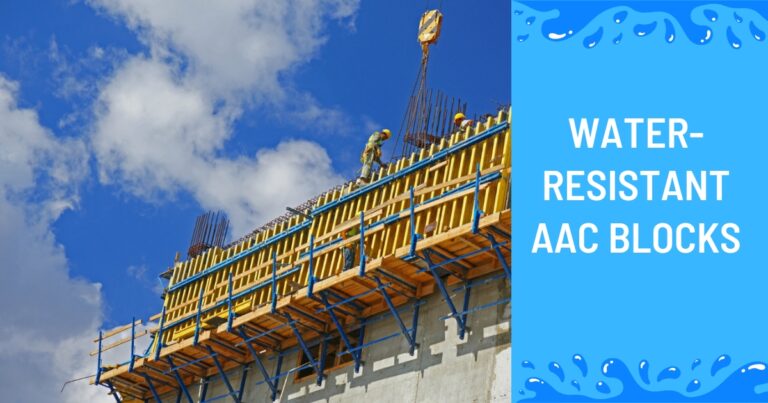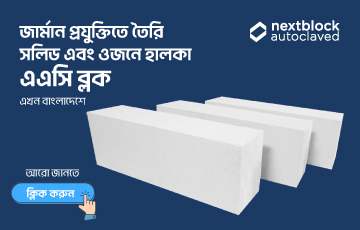AAC blocks are the ideal choice for construction in any season, especially in regions that receive heavy rainfall. Their water-resistant nature makes AAC blocks a reliable choice for ensuring the longevity and durability of any structure, even in areas prone to frequent rain or high humidity. With AAC blocks, builders and homeowners can have peace of mind knowing that their construction will not be compromised by water damage, resulting in lower maintenance costs and a longer lifespan for the building. Whether it’s for a new home, an office building, or a hospital, water-resistant AAC blocks are a smart investment for any construction industry.
How does the Rainy Season affect cement and concrete?
During the rainy season leads to a lot of issues in the concrete and cementing process.
Cement plays an important part in concrete, frequently used extensively in construction project. The quality of cement is crucial in determining the strength and durability of concrete. However, in the rainy season, cement has the tendency to absorb moisture from the air, which may affect its quality. Moisture can interact with the cement, causing its premature hardness. This may cause a decrease in workability and concrete strength, potentially resulting in structural issues.
Aside from its effect on cement, the rainy season can also impact the characteristics of concrete. Because of its porous material structure, water has the ability to crack cracks on the exterior in concrete and move through capillary pores to reach the built reinforcement. Once the reinforcement comes into contact with water, it corrodes and expands, causing the formation of more cracks in concrete and causing more water into the concrete. Due to corroded reinforcement, the load-bearing capacity of concrete decreases, while the risk of seepage increases. Cracks happen due to the concrete expanding and contracting in response to temperature and moisture fluctuations. During the monsoon season, the adhesion qualities of concrete may be impacted, resulting in a decrease in bond strength. Due to this, the concrete may detach from the reinforcement, causing structural problems.
In this blog, we will explore why AAC blocks are considered a perfect choice for construction during the rainy season.
Superior Moisture Resistance
One significant benefit of using AAC blocks lies in their remarkable resistance to moisture. Unlike conventional clay brick or concrete blocks, AAC blocks consist of autoclaved aerated concrete blocks that incorporate numerous air voids. These air voids offer superior insulation properties and effectively inhibit water absorption. The closed-cell composition of AAC blocks enhances their ability to withstand moisture infiltration, thereby decreasing the likelihood of dampness, mold formation, and structural deterioration, particularly crucial during the rainy season.
Thermal Insulation Properties
AAC blocks have excellent thermal insulation properties, which are particularly beneficial in regions with heavy rainfall. The air voids in AAC blocks act as insulating pockets, reducing heat resistant and maintaining a comfortable indoor temperature. In contrast to other construction materials, AAC blocks are fire resistant up to 1200℃. Autoclaved aerated concrete is also earthquake resistant because of its lightweight. AAC blocks are more reliable than traditional building material. During the rainy season, when the external environment is cooler, AAC blocks help to keep the interiors warm and prevent issues like condensation and moisture buildup on wall and ceiling.
Long-term Structural Integrity
The use of AAC blocks in construction projects has been proven to significantly increase the long-term structural integrity of buildings. This is especially important in areas that experience high levels of rainfall and moisture, as these conditions can weaken traditional building material over time. AAC blocks are known for their durability and resistance to moisture, making them an ideal choice for ensuring the longevity of structures in the rainy season. Additionally, their lightweight nature allows for easier handling and installation, reducing the risk of structural damage during the construction process. Overall, the use of Autoclaved aerated concrete(AAC blocks) can greatly contribute to the overall stability and durability of buildings, providing peace of mind for both builders and occupants alike.
Reduced Water Ingress
AAC blocks are known for their well-sealed structure that minimizes gaps and joints, making them highly resistant to water seepage. This feature helps prevent leaks and water-related damage, ensuring a dry and comfortable indoor environment for the building’s occupants. Additionally, their ability to reduce water ingress through walls, floors, and ceilings significantly contributes to the overall protection of the structure during heavy rainfall.
Efflorescence Reduction
Detailing the advantages of utilizing water resistant AAC blocks, especially in areas prone to heavy rainfall, is crucial for ensuring the longevity and durability of structures. One key benefit is the minimal occurrence of efflorescence, a common problem that often worsens in damp conditions. Efflorescence, which manifests as white, powdery deposits on surfaces, is a result of water-soluble salts being drawn to the surface of masonry due to moisture exposure. By using water resistant AAC blocks, this phenomenon is significantly reduced, preventing unsightly marks and maintaining the aesthetic appeal of buildings in rainy seasons.
Energy Efficiency
The thermal insulation qualities of AAC blocks, particularly their ability to minimize energy usage for heating and cooling, stand as a pivotal benefit, especially during the rainy seasons. In regions prone to heavy rainfall, the efficiency of AAC blocks in maintaining optimal indoor temperatures not only enhances comfort but also contributes significantly to reducing overall energy costs.
Resistance to Mold and Mildew
AAC blocks are made from a mixture of cement, lime, sand, and aluminum powder, which creates a highly porous structure. This porous nature allows for excellent insulation properties, but also serves as a deterrent for mold and mildew growth. The lack of organic material in AAC blocks means that there are no nutrients available for mold spores to thrive, making it a highly resistant material in damp environments. Additionally, the alkaline pH of AAC blocks further inhibits the growth of mold and mildew, ensuring a healthier indoor environment for occupants.
Resistance to Algae and Fungal Growth
The smooth surface of AAC blocks makes it difficult for algae and fungi to adhere and grow, further preventing the spread of these unwanted organisms. This resistance to growth not only helps to maintain the aesthetics of the building but also contributes to the overall longevity and durability of the structure. By choosing AAC blocks for construction, homeowners and builders can enjoy a low-maintenance and sustainable building material that offers long-term protection against the damaging effects of algae and fungal growth.
Enhanced Sound Insulation
The rainy season often brings heavy rainfall and thunderstorms, accompanied by loud noises. AAC blocks also have thermal insulation properties, helping to regulate indoor temperatures and reduce energy costs. This makes them a popular choice for construction in areas with extreme weather conditions. In combination with their sound insulation capabilities, AAC blocks offer a practical solution for creating a quiet and comfortable living space, even during the stormy rainy season.
Environmental Benefits
During the rainy season, choosing AAC blocks for construction can be a sustainable and eco-friendly option. Their moisture-resistant properties make them ideal for regions with heavy rainfall, as they can withstand the challenges of the climate. Additionally, their thermal insulation properties help regulate indoor temperatures, reducing the need for excessive heating or cooling during wet weather. By using AAC blocks, not only are you benefiting the environment but also ensuring long-lasting and sustainable buildings in rainy regions.
Speed of Construction
In construction projects, AAC blocks can significantly speed up the construction process. Their larger size and lightweight properties allow for quicker installation, ultimately reducing overall construction time. This advantage is especially beneficial during the rainy season when delays due to weather conditions can be common. By using AAC blocks, construction projects can continue to progress efficiently, even in inclement weather conditions.
Structural Stability
Incorporating AAC blocks in construction during the rainy season can help ensure structural stability. With their high compressive strength and ability to withstand heavy rainfall forces, including wind pressure and hydrostatic loads, AAC blocks help keep buildings strong and resilient. This minimizes the risk of structural damage during inclement weather, providing a safe and stable structure for occupants.
Cost-effectiveness and Maintenance
The cost-effectiveness and practicality of using AAC blocks in rainy climates make them a highly desirable option for builders and developers looking to create durable, efficient, and long-lasting structures. In addition to their resistance to moisture and ability to withstand harsh weather conditions, AAC blocks also offer superior thermal insulation properties, helping to regulate indoor temperatures and reduce energy costs. This makes them an environmentally friendly choice for sustainable construction projects, as they can contribute to lower carbon footprints and energy consumption. Furthermore, the lightweight nature of AAC blocks makes them easier to transport and install, leading to faster construction times and potentially lower labor costs.
AAC Blocks Considered The Perfect Choice for Rainy Season
Despite the excitement related to the monsoon season, it may give rise to significant issues if the house’s structure is not assessed in advance. For those facing recurring problems, consider utilizing Nextblock’s water-resistant AAC blocks for a without any concerns during the rainy season.
Autoclaved aerated concrete block (AAC block) are made of lime, sand, cement, and water, resulting in a lightweight product. Choosing this building material will make your construction project more efficient and reduce the overall weight of the building. Moreover, they need minimal electricity to function and are easy to relocate. One of the major benefits of AAC block is their impermeability to water. The microscopic structure of the AAC block prevents capillary action, ensuring it is impermeable to water. Silicone-based additives are utilized to enhance the material’s water resistance capabilities.
Frequently Asked Questions
The exceptional water resistance of AAC blocks is derived from their dense microscopic structure, effectively inhibiting capillary action. These blocks, made from non-biodegradable materials, inherently resist rot and mold, ensuring long-lasting durability in construction projects. In addition, their remarkable thermal insulation properties enhance energy efficiency in buildings, positioning AAC blocks as a sustainable choice for construction. By offering a blend of water resistance, durability, and thermal efficiency, AAC blocks not only provide reliability but also promote eco-friendly construction practices, aligning with modern sustainability standards.
Autoclaved aerated concrete block typically absorbs water in the range of over 8% to 11.1% of its dry unit weight. The water absorption capacity of AAC is influenced by factors such as autoclaving temperature, pressure, aluminum content, and the unit weight of the AAC.






